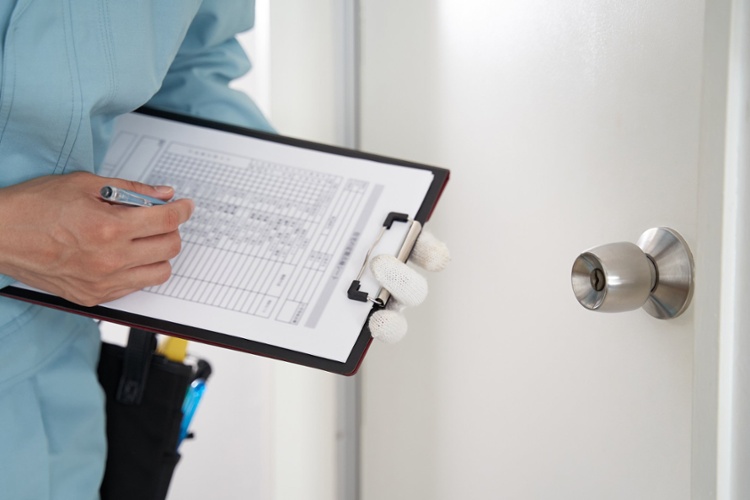A tenant move-out checklist can help streamline the inspection process when the tenant moves out and minimize the amount of rental income lost between tenant turns.
In this article, we’ll show you how to create a tenant move-out checklist, key items to inspect in a rental property when a tenant leaves, and the difference between damages and normal wear and tear.
What is a Tenant Move-Out Checklist?
A move-out checklist details the condition of a rental property when the tenant vacates (inside and outside for single-family rentals). Move-out checklists can be used by both landlords and tenants to compare the property’s condition on the day of moving out to the day the tenant moved in.
Although generic move-out lists can be downloaded online from websites such as Zillow, it’s best to create a specific tenant move-out checklist for each property that you own and attach it as an addendum to the rental agreement.
That’s because rental properties can have unique features such as a wood-burning fireplace or an oversized 2-car garage. The rental agreement the tenant signs may require the fireplace to be clean of ashes and other debris, or that any oil or grease stains be cleaned from the garage floor.

Why Using a Move-Out Checklist is Important
The most important use of a move-out checklist is to determine whether the tenant’s security deposit will be returned in full, or if money will be withheld from the security deposit to pay for damages caused by the tenant beyond normal wear and tear.
Security deposit disputes often occur between landlords and tenants. A tenant will be extra motivated to return the rental property in pristine condition if they know they will receive a full security deposit refund.
The better condition the property is in when the old tenant leaves, the quicker the rental can be turned over to a new tenant. This helps to keep turnover costs lower and minimizes rental income lost due to vacancy.
Unfortunately, sometimes outgoing tenants try to claim that they are not liable for property damage because the damage occurred after they left. A move-out checklist signed by the tenant and the landlord, along with time-stamped photos taken at the time of the move-out inspection, can be used as ironclad evidence of the condition the tenant left the property in (which is beneficial for both parties).
How a Create a Tenant Move-Out Checklist
Prepare ahead of time to minimize the number of days your property will be vacant and not generating rent.
The tenant should contact the landlord 3-5 days in advance to schedule the inspection. Prior to the day the tenant is moving out you should confirm the date and time of the inspection with the tenant.
Be sure to bring any documents from when the tenant moved in – including the move-in checklist and any time-stamped photos – to review the before and after condition of the property in the presence of the tenant.
Remind the tenant that all utilities must be left on until the move-out checklist is complete. Don’t forget to take photos of any damage found during the move-out inspection to add to the tenant’s permanent file.
At the end of the move-out inspection have the tenant sign the move-out checklist and give a copy to the tenant.
A tenant move-out checklist should include the following items for inspection:
General
- Floors should be swept and mopped, and carpets vacuumed.
- Walls, door frames, ceilings, and ceiling fans should be dusted and cleaned, and free of smudges or marks.
- Woodwork and trim such as window sills and baseboards should be washed.
- Air conditioning and heating systems, including vents and ductwork, and condition of the filters.
- Light fixtures should clean throughout the house with light bulbs replaced if necessary.
- Front and back yards must be neat and trimmed and free of any debris.
Kitchen and Laundry
- Check the water pressure and drainage by turning the faucet on, and check for leaks under the kitchen sink that could cause mold or water damage.
- Inspect the countertops and cabinets for chips or cracks.
- Open and close each door and drawer to ensure they are functioning properly, and to see if any hardware is missing.
- Stove burners should be working properly and be clean, along with the oven and racks.
- Run the dishwasher to make sure it works and drains properly, and check the dishwasher door seal for signs of leaks.
- Verify the refrigerator and freezer are clean and functioning properly, that the condenser coils are free of dust, and that the temperatures are set correctly.
- Run the washing machine and dryer on a short cycle, making sure the units are balanced and not shaking during a wash and dry cycle, that the washer is filling and draining properly, and that the dryer exhaust vent is free of lint.
Living and Bedrooms
Note the condition of each inspection item, using a ranking of 1-Poor, 2-Fair, 3-Average, 4-Good, and 5-Excellent:
- Floors and carpets
- Walls and baseboards
- Doors and door frames
- Closets including doors, rods, and shelves
- Windows and ledges, including window coverings such as blinds or drapes
- Ceiling and ceiling fans
- Light fixtures, electrical sockets, and communication jacks
- Smoke alarms and carbon monoxide detectors
Bathrooms
Bathrooms frequently have hidden damage due to the amount of daily use, water, and steam. Items to check in each bathroom include:
- Toilets for leaks
- Sinks for stoppers and drainage
- Faucets including the aerator that may accumulate debris and slow water flow
- Shower heads for hard water deposits
- Bathtubs for minor cracks or peeling
- Areas under the bathroom vanity for indications of water leaks or mold growth
- Mirror condition
- Walls and ceilings for signs of mold or water damage
- Windows
Miscellaneous
Finally, tie up any loose ends by:
- Removing any garbage accidentally left in pantries and cabinets.
- Ensuring all tenant belongings and possessions are removed.
- Removing any trash left at the curb.
- Collecting all of the keys, including any garage door openers.
- Obtaining the tenant’s forwarding address.
Security Deposit
Determine how much of the refundable security deposit will be returned, if possible in the presence of the tenant. This way you can explain why money for repairs may be withheld, using the documents and photos you brought from the move-in inspection to make your case.
Be sure to return the security deposit to the tenant within the time frame required by your local landlord-tenant laws, normally 15-30 days after the lease has ended and the tenant has moved out. Itemize any deductions from the security deposit used to repair damages beyond normal wear and tear.
What is Normal Wear and Tear?
Nothing lasts forever. For example, when your favorite t-shirt from college finally wears out, you wouldn’t go back to the school and demand a new replacement shirt at no charge. Wear and tear in rental property works the same way.
The definition of normal wear and tear varies from state to state and can be difficult to precisely define. But generally speaking, wear and tear are what would occur no matter who lived in the house, including yourself.
Carpeting eventually wears out, wooden floors get scratched, bathroom tub and shower tiles become dull and paint on the walls and door frames eventually loses its luster.
Another way to think about wear and tear is by using the IRS guidelines for the lifespan of certain assets in a rental property. The IRS considers an appliance such as a refrigerator to fully depreciate over only five years.
Of course, that doesn’t mean you’re going to replace the refrigerator in a rental property every five years. But this does give you a good idea of how long some items are expected to last due to normal wear and tear.
Create a Move-In Checklist for New Tenants
Throughout this article, we’ve discussed using a move-in checklist to compare to the move-out checklist when assessing the before and after condition of your rental property.
A move-in checklist for tenants documents the condition of the property when the tenants first take possession. It’s a good idea to use the same form for when tenants move in and out so that you can make an “apples to apples” comparison of the property condition.
You can also use a move-in checklist to create the right expectations with the tenant when they move out. Explain to the tenant how moving out works, including giving proper notice and maintaining the house in good condition as called for in the lease.
Final Thoughts
A move-out inspection may feel confrontational when done with the tenant present, but it doesn’t have to be that way. Of course, the tenant should be there for the final review, but using a tenant move-out checklist can benefit both the landlord and the tenant.
You’ll avoid hurt feelings and potential conflicts, and reduce the vacancy time between tenants. At the end of the day, a tenant move-out checklist can help keep the cash flow from your rental property healthy and strong.










